Pranks

Thank goodness April Fool’s Day is coming up. I really need some diversion from the news these days. So, some innocent pranking is in order. At work (if you’re still working like we are) or at home. Let’s get started: (top) If you have time and a budget for aluminum foil, this one is amazing. (row two left)Super Glue coins on the sidewalk where you can keep an eye out for people walking by. (row two right) Tape an air horn below a co-worker’s seat. Make sure others near her/him are aware of the potential for noise. (row three) The room full of balloons fake-out. (row four) Place a sheet of bubble wrap under a throw rug. (row five – three photos) The chicken soup shower. Probably don’t do this to your wife but one of your kids or a room mate works. They’ll eventually get over it. (row six) Another air horn trick. Securely tape it to the wall so the door handle will set it off. Again, warn people nearby. (row seven) Put a “sold” sign in front of your house. The kids or wife or husband as well as the neighbors will certainly be amused by this. (row eight left) Tetris fans—cover a wall with colored post-it notes! (row eight right) Tear off a corner of a dollar bill, attached to an April Fool note and let the fun begin. (row nine left) Paint clear nail polish all over a bar of soap and let dry. (row nine right) The old “Kick Me” sign slapped on someone’s back never gets old and always works. (row 10 left) Not so much a prank as it is a fun surprise. (row 10 left) Soak an empty TP roll and mold it into the shape of a poopie. (row 11 left) Stretch plastic wrap across the toilet bowl and put the seat down. (row 11 right) Top off an older toothpaste tube with Mayonnaise…yuck!! (row 12, three images) Mess with your kids…freeze their favorite cereal overnight for your morning delight. (row 13 left) Replace the chocolate in those foil wrappers with grapes. (row 13 right) Make a pan of brown “Es” to share with the family. (row 14) Back to messing with your kids… suff some TP into the toe of their shoes. See if they think their feet grew overnight. (row 15) Cut some translucent paper in the shape of a milk spill, close the lid and wait for the owner to open the lid. It should work to startle them for an instant. I could go on and on with these but I’ve probably gone on to much already. Have a little fun! We all could use some about now.
Hope you are faring ok with your family during these unprecedented times. As a “designated essential supplier” to many businesses and industries, we remain open and quite busy, doing our part working on your PIA (@%$) JOBS! and following all the proper guidelines for safety, distancing and cleanliness. With April Fools’ Day just around the corner, I thought I’d share a little history, and some really fun pranks pulled from over the decades. I remember years ago when the girls were very little, Jackie and I switched their rooms around while they were sleeping! (very fun to watch them wake up!) The girls in turn buttoned every one of our shirts together in our closets! Special thanks to history.com, wikipedia and beano.com for the trivia. Enjoy, and be sure to send me some of your favorite pranks.
Although April Fools’ Day, also called All Fools’ Day, has been celebrated for several centuries by different cultures, its exact origins remain a mystery.
Some historians speculate that April Fools’ Day dates back to 1582, when France switched from the Julian calendar to the Gregorian calendar, as called for by the Council of Trent in 1563. People who were slow to get the news or failed to recognize that the start of the new year had moved to January 1 and continued to celebrate it during the last week of March through April 1 became the butt of jokes and hoaxes – hence the name “fools”. These pranks included having paper fish placed on their backs and being referred to as “poisson d’avril” (April fish), said to symbolize a young, easily caught fish and a gullible person.
Historians have also linked April Fools’ Day to festivals such as Hilaria, which was celebrated in ancient Rome at the end of March and involved people dressing up in disguises. There’s also speculation that April Fools’ Day was tied to the vernal equinox, or first day of spring in the Northern Hemisphere, when Mother Nature fooled people with changing, unpredictable weather.
April Fools’ Day spread throughout Britain during the 18th century. In Scotland, the tradition became a two-day event, starting with “hunting the gowk,” in which people were sent on phony errands (gowk is a word for cuckoo bird, a symbol for fool) and followed by Tailie Day, which involved pranks played on people’s derrieres, such as pinning fake tails or “kick me” signs on them.
In modern times, people have gone to great lengths to create elaborate April Fools’ Day hoaxes. Newspapers, radio and TV stations and Web sites have participated in the April 1 tradition of reporting outrageous fictional claims that have fooled their audiences. Here are a couple of classics:
- – In January of 1749, London newspapers advertised that in an upcoming show, a man would squeeze his entire body into a wine bottle and then sing while inside of it. The ad promised that, “during his stay in the bottle, any Person may handle it, and see plainly that it does not exceed a common Tavern Bottle.” The ad promised the show would feature other tricks as well, including communicating with the dead. Legend has it that the ad was the result of a bet between the Duke of Portland and the Earl of Chesterfield. Reportedly, the duke bet that he could advertise something impossible and still “find fools enough in London to fill a playhouse and pay handsomely for the privilege of being there.” And apparently, he was right. The night of the show, every seat in the house was filled, but no performer ever showed up. Realizing they had been duped, the audience rioted.
- – On April 1, 1905, a German newspaper called the Berliner Tageblatt announced that thieves had dug a tunnel underneath the U.S. Federal Treasury in Washington, D.C., and stolen America’s silver and gold (this was before the U.S. built its Bullion Depository in Fort Knox, Kentucky). The newspaper said the heist was organized by American robber barons, whose burglars dug the tunnel over three years and made away with over $268 million; and that U.S. authorities were trying to hunt down the thieves while publicly covering up the fact that the country had been robbed. The story spread quickly through European newspapers before people realized that it was an April Fools’ Day prank by Louis Viereck, a New York correspondent for the Berliner Tageblatt who published the joke article under a fake name.
- – On April 1, 1957, a news broadcaster told his British audience that Ticino, a Swiss region near the Italian border, had had “an exceptionally heavy spaghetti crop” that year. The camera cut to footage of people picking spaghetti off of trees and bushes, then sitting down at a table to eat some of their “real, home-grown spaghetti.” At the time, spaghetti wasn’t necessarily a dish that British people would’ve known about. That doesn’t mean that no one realized the segment was a prank—some viewers were upset the BBC had aired a fictional segment during a serious news program. But other viewers reportedly asked about how they could grow their own spaghetti at home.
- – In 1959, students in São Paulo, Brazil, who were tired of the city’s overflowing sewers and inflated prices launched a campaign to elect a rhinoceros to the city council. The rhino’s name was Cacareco (Portuguese for “rubbish”), and she was already a popular figure in São Paulo when the students launched her campaign. The four-year-old had moved to the city from Rio de Janeiro when São Paulo’s zoo opened and was scheduled to return to Rio soon. When the students looked at the 540 candidates vying for São Paulo’s 45 city council seats and feared that none of them would address the city’s problems, they decided to make a point by asking people to vote for the popular rhino instead. Cacareco won a city council seat with a whopping 100,000 votes, far more than any other candidate (the closest runner-up got about 10,000). Of course, she didn’t end up serving on the city council because the election board disqualified her. But she remains one of the most famous protest votes in Brazilian history.
- – Caltech has a long history of pranking other schools. One of its most famous pranks happened during the 1961 Rose Bowl football game in Pasadena, where Caltech is located. The game was between the University of Washington’s Huskies and the University of Minnesota’s Golden Gophers. During the game, Washington cheerleaders handed out colored cards to the Huskies’ side and told them that if they held the cards up at halftime, the cards would spell “Huskies.” But when halftime came and the fans held the cards up, they ended up spelling “Caltech.” It was so weird and unexpected (Caltech wasn’t even playing in the game!) that the band on the field stopped mid-song. It later came out that fourteen Caltech students had orchestrated the prank by breaking into the cheerleaders’ hotel rooms and switching the instruction sheets for the card stunt.
- – In 1969, Rolling Stone music critic Greil Marcus published a piece spoofing the trend of big name rock stars forming “supergroups.” One of the most popular supergroups in the ‘60s was Cream: its guitarist Eric Clapton was already famous for playing with the Yardbirds, while drummer Ginger Baker and bassist Jack Bruce were already known for playing in the Graham Bond Organisation. Marcus penned a gushing review to a nonexistent bootleg album by the “Masked Marauders,” a secret supergroup he said was made up of Bob Dylan, Mick Jagger, John Lennon, Paul McCartney and George Harrison. The fake review garnered real interest in the album, and Marcus ended up writing and recording the songs he’d made up; then Warner Brothers bought the songs and released the album. Two decades after the “Masked Marauders” review, Bob Dylan and George Harrison actually did join a supergroup with Tom Petty called the Traveling Wilburys.
- – In 1985, Sports Illustrated tricked many of its readers when it ran a made-up article about a rookie pitcher named Sidd Finch who could throw a fastball over 168 miles per hour.
- – Richard Branson, the billionaire founder of the Virgin Group, has a well-documented love of April Fools’ Day. In 1989, on the evening before April Fool’s Day, residents outside of London spotted a flying saucer that appeared to land in a nearby field in Surrey. Police officers went to the field to investigate the supposed UFO and were probably surprised when they actually found one. As they approached the flying saucer, a door opened, and a silver-clad figure walked out. The cops promptly ran away. Little did they know, Branson was hiding out in the UFO behind his silver-clad companion, whose name was Don Cameron. The two of them had taken off in the flying saucer—which was actually a hot-air balloon—and planned to land in Hyde Park on April 1 as a prank. However, changing winds forced them to land a little earlier in Surrey.
- – In 1996, Taco Bell, the fast-food restaurant chain, duped people when it announced it had agreed to purchase Philadelphia’s Liberty Bell and intended to rename it the Taco Liberty Bell. In 1998, after Burger King advertised a “Left-Handed Whopper,” scores of clueless customers requested the fake sandwich.
- – and now for something very timely – In 2015, Cottonelle tweeted that it was introducing left-handed toilet paper for all those southpaws out there. The joke followed a 1998 stunt by Burger King about its new “left handed” Whopper.
::::::::::::::::::::::::::::::::::::::::::::::::::::::::::::::::::::::::::::::::::::::::::
DO YOU LIKE CONTESTS?
Me, too.
As you may know the Kowalski Heat Treating logo finds its way into the visuals of my Friday posts.
I. Love. My. Logo.
One week there could be three logos. The next week there could be 15 logos. And sometimes the logo is very small or just a partial logo showing. But there are always logos in some of the pictures.
So, I challenge you, my beloved readers, to count them and send me a quick email with the total number of logos in the Friday post. On the following Tuesday I’ll pick a winner from the correct answers and send that lucky person some great KHT swag.
So, start counting and good luck! Oh, and the logos at the very top header don’t count. Just in the pictures area. Got it? Good. :-)))) Have fun!!
::::::::::::::::::::::::::::::::::::::::::::::::::::::::::::::::::::::::::::::::::::::::::



























